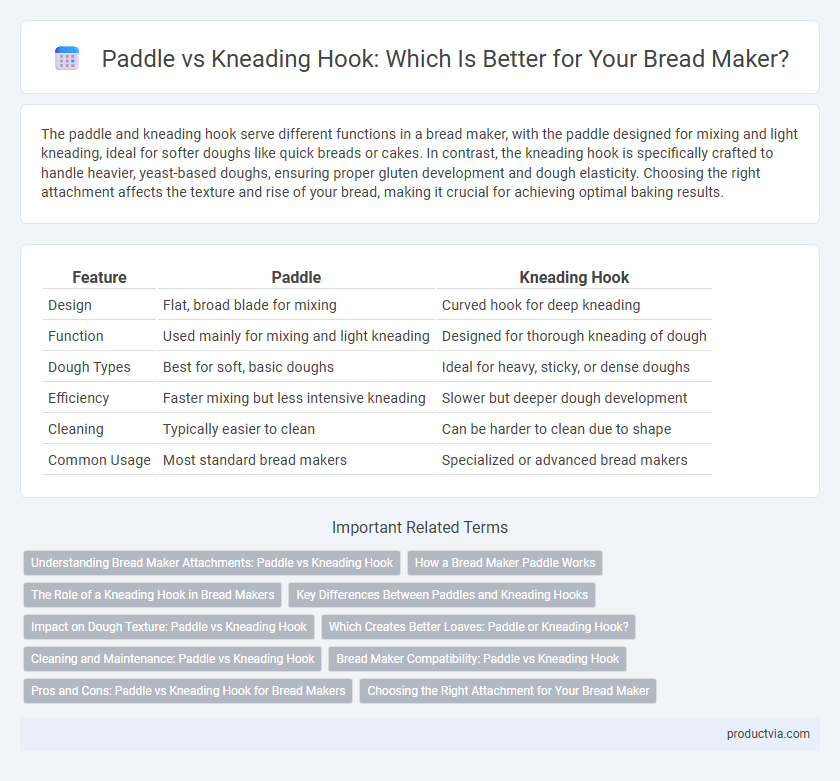The paddle and kneading hook serve different functions in a bread maker, with the paddle designed for mixing and light kneading, ideal for softer doughs like quick breads or cakes. In contrast, the kneading hook is specifically crafted to handle heavier, yeast-based doughs, ensuring proper gluten development and dough elasticity. Choosing the right attachment affects the texture and rise of your bread, making it crucial for achieving optimal baking results.
Table of Comparison
| Feature | Paddle | Kneading Hook |
|---|---|---|
| Design | Flat, broad blade for mixing | Curved hook for deep kneading |
| Function | Used mainly for mixing and light kneading | Designed for thorough kneading of dough |
| Dough Types | Best for soft, basic doughs | Ideal for heavy, sticky, or dense doughs |
| Efficiency | Faster mixing but less intensive kneading | Slower but deeper dough development |
| Cleaning | Typically easier to clean | Can be harder to clean due to shape |
| Common Usage | Most standard bread makers | Specialized or advanced bread makers |
Understanding Bread Maker Attachments: Paddle vs Kneading Hook
Bread maker attachments include the paddle and kneading hook, each designed to enhance dough preparation differently. The paddle is best suited for mixing and kneading lighter doughs, ensuring smooth and consistent batter, while the kneading hook specializes in working heavier, denser doughs like whole wheat or artisan bread, mimicking manual kneading motions. Choosing the right attachment optimizes texture and rise, directly impacting the quality of the bread produced.
How a Bread Maker Paddle Works
A bread maker paddle is designed to mix and knead dough by rotating within the bread pan, effectively combining ingredients and developing gluten strands for a consistent texture. Its flat, flexible blades lift and fold the dough, ensuring thorough mixing without overworking it, which is crucial for optimal bread rise and crumb structure. Unlike a kneading hook, the paddle balances strength and gentleness, making it ideal for various dough types from basic bread to enriched varieties.
The Role of a Kneading Hook in Bread Makers
The kneading hook in bread makers is essential for thoroughly mixing and kneading dough to develop gluten structure, which ensures a perfect texture and rise. Unlike a paddle, the kneading hook is designed to handle dense doughs such as whole wheat or multigrain, providing consistent kneading without tearing the dough. This tool optimizes the bread-making process by delivering uniform kneading, resulting in evenly textured, well-risen loaves.
Key Differences Between Paddles and Kneading Hooks
Paddles in bread makers are typically flat and designed for mixing and gentle folding, ensuring ingredients combine without overworking the dough, which is ideal for softer or quicker bread types. Kneading hooks, on the other hand, have a spiral or hook shape that mimics hand kneading, effectively developing gluten structure in denser, yeast-leavened doughs like artisan or whole wheat breads. The key difference lies in motion and dough interaction: paddles mix and fold, while hooks knead deeply to improve dough elasticity and rise quality.
Impact on Dough Texture: Paddle vs Kneading Hook
The paddle in a bread maker creates a denser, more compact dough texture by mixing ingredients quickly and cutting through the dough. In contrast, a kneading hook gently stretches and folds the dough, promoting better gluten development and resulting in a lighter, airier bread crumb. Choosing between a paddle and a kneading hook directly impacts the final bread's texture and crumb structure.
Which Creates Better Loaves: Paddle or Kneading Hook?
The kneading hook is designed to thoroughly mix and stretch dough, resulting in better gluten development and improved loaf texture compared to the paddle. Bread makers equipped with a kneading hook typically produce bread with a more uniform crumb and enhanced rise. Paddles may be efficient for mixing but often fall short in kneading, leading to denser, less aerated loaves.
Cleaning and Maintenance: Paddle vs Kneading Hook
The paddle in bread makers often features a compact design that traps less dough, allowing easier cleaning compared to the bulkier kneading hook, which can accumulate dough in its crevices. Stainless steel kneading hooks may require more thorough scrubbing to remove sticky residue, while non-stick paddles typically facilitate quicker maintenance. Regular cleaning of both components is essential to prevent buildup and ensure longevity of the bread maker's mixing performance.
Bread Maker Compatibility: Paddle vs Kneading Hook
Bread makers often come with either a paddle or a kneading hook, each designed for specific dough types and textures. Paddles are typically compatible with machines intended for dense bread doughs, providing thorough mixing without overworking the gluten, while kneading hooks suit bread makers designed for softer, elastic doughs, ensuring even stretching and development. Checking the bread maker's manual for compatibility ensures effective kneading and optimal bread texture.
Pros and Cons: Paddle vs Kneading Hook for Bread Makers
Paddles in bread makers offer efficient and thorough mixing, ideal for standard doughs, but they can sometimes leave holes in the crust due to their fixed position. Kneading hooks provide gentle and consistent dough kneading, reducing air pockets and improving texture, though they may not mix ingredients as uniformly, especially in dense doughs. Choosing between a paddle and a kneading hook depends on the type of bread, with paddles excelling in quick mixes and kneading hooks favoring artisan, high-hydration doughs.
Choosing the Right Attachment for Your Bread Maker
Selecting the right attachment for your bread maker directly influences dough texture and bread quality; paddles excel in mixing batter and softer doughs, while kneading hooks provide superior gluten development for denser bread varieties. Compatibility with your bread maker model ensures efficient operation, preventing motor strain and uneven mixing. Understanding dough types and baking goals helps determine whether a paddle or kneading hook best suits your bread-making needs.
Paddle vs Kneading Hook for Bread Maker Infographic

 productvia.com
productvia.com